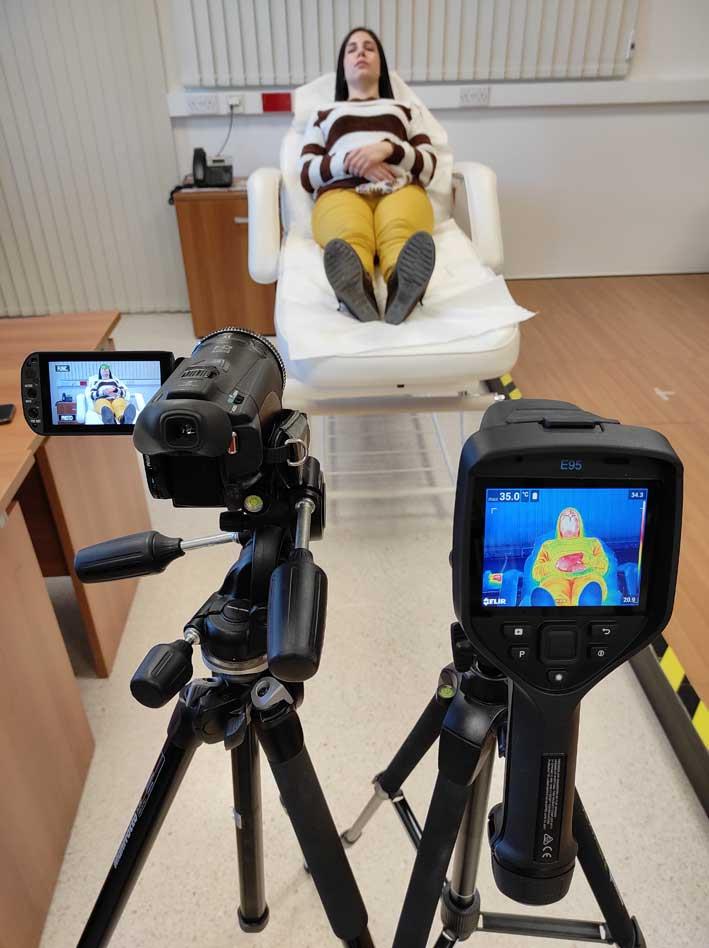The monitoring of vital signs such as the heart rate and breathing rate is important in many settings, especially in the medical field. Most patients in hospitals will have these vital signs monitored, sometimes continuously, each day. Classically vital signs are monitored via devices such as the electrocardiogram (ECG), involving electrodes being attached to the skin on the chest, to read the small electrical currents generated by the beating heart. Breathing rates and patterns are recorded either by looking at particular values on the ECG readings that change with motion of the chest wall or via chest belts which are strapped around the chest and count each chest expansion. Blood oxygen saturations are monitored using finger probes that shine LED lights at specific wavelengths and produce a waveform from which the heart rate can also be recorded.
These methods have been around for several decades and are proven to be reliable and very useful. However, they pose a number of problems. Having wires attached, especially for prolonged periods of time, is uncomfortable for many patients and will restrict their movement and ability to perform simple tasks such as visiting the bathroom or changing one's clothes. Delayed mobility after surgery has also been associated with complications and delay in discharge from hospital. These wires are also prone to become tangled and dislodged especially during the night as the patient moves in bed, leading to loss of readings of the person's vital signs.

Traditional methods of monitoring can also spread infections between patients if they are inadequately disinfected. This is a particularly serious issue with the rise of bacteria which are resistant to most antibiotics we have available, making them very difficult to treat. The World Health Organisation in fact considers the spread of these organisms as one of the biggest public health emergencies of the moment.
In the case of infectious diseases, as is evident during the current pandemic, non-contact vital signs monitors will reduce the risk to staff members having to come into contact with infected patients and will also reduce usage of personal protective clothing which is a limited resource. In the case of patients with weak immune systems, such as those on chemotherapy, non-contact monitoring reduces the risk of these patients having a potentially dangerous disease transmitted to them.
There are also certain situations where use of contact-based means of vital signs monitoring may not be practical. Examples include patients with extensive skin burns, where there may not be enough healthy skin to place ECG leads in order to obtain a reliable reading. Large chest wounds may make it unsafe and impossible to use chest belts. More commonly, wearing ECG electrodes for a prolonged time can cause irritation to many people, such as those with sensitive skin and babies born preterm.
These reasons underlay the recent interest in developing means of monitoring vital signs in a contactless manner. Contactless methods for vital sign monitoring do not require wires or leads and can therefore overcome all the problems listed above.
Heart rate and rhythm can be extracted from videos of the subject, taken using standard digital camera technologies and subsequently analyse these videos using advanced algorithms to detect very subtle fluctuations in the colour of the skin, invisible to the naked eye. These cyclic fluctuations occur with every heart beat as the heart pumps blood through the body. The breathing rate can be monitored by measuring minute changes in the temperature of the skin around the nostrils every time the patient exhales. These changes may be recorded with the use of a thermal camera, from which the patient's breathing rate can then be estimated.
The Non-Invasive Vital Signs Monitoring Project (NIVS) is a joint research effort between the University of Malta, specifically the Centre of Biomedical Cybernetics with Dr Owen Falzon overseeing the project, Prof. Jean Calleja Agius from the Department of Anatomy and Dr Stephen Sciberras from Mater Dei Hospital heading the clinical aspect. Dr Nicole Grech and Ing. Lucianne Gauci are research support officers for the project. The project is funded by the Malta Council for Science and Technology (R&I Technology Development Programme R&I 2018-004T) and aims to develop and improve contactless methods for monitoring human vital signs in real life clinical situations.
These novel methods of monitoring open up a whole new era of patient care with increased comfort and convenience and the ability for better remote monitoring, especially in situations where isolation is necessary as is the case in the current ongoing pandemic.